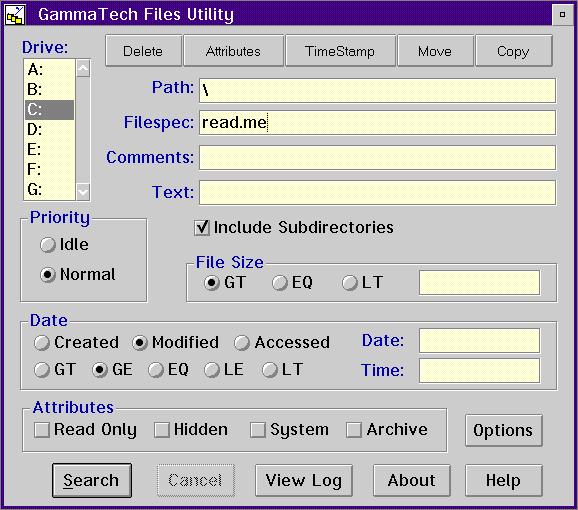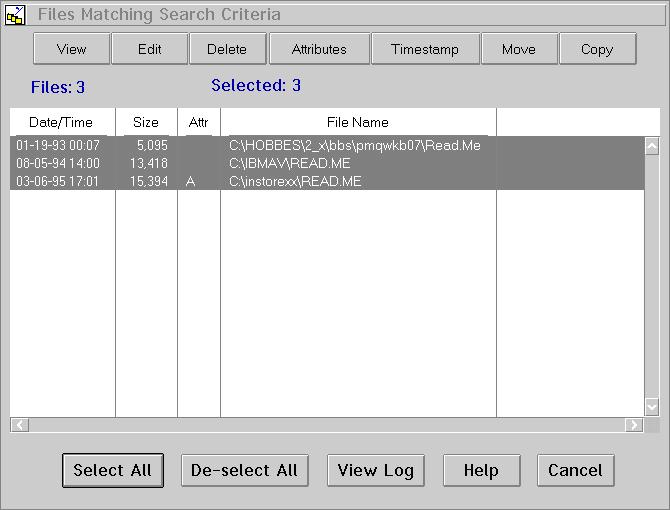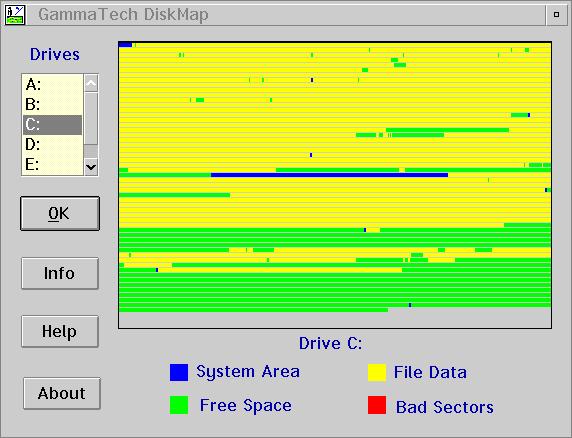|
SCOUG OS/2 For You - June 1995GammaTech Utilities for OS/2Version 3.0 - continued
Files - Super Seek and Scan Files Previous versions of the Utilities included separate Find, Attribute, and Delete programs to, respectively, locate files with particular names or containing a particular string of characters; modify any or all of the attributes associated with a file or a group of files; and delete one or more files meeting defined search criteria. These individual utilities each served capably at their designated functions, but they lacked the integration necessary to make best use of their capabilities. Version 3 replaces these older utilities with a single program called Files. It combines all the functions of the previous three programs into a single facility in such a way that the new utility has much more power than the programs it replaces, making it easy to perform various kinds of file and disk maintenance. 
Characterizing this new utility is really quite difficult. It may help to think of it as a super version of the Seek and Scan Files utility that can be found in the OS/2 Productivity folder. GammaTech Files provides all the functions of Seek and Scan -- and a whole lot more.

The Files utility gives you extensive seek and scan functionality. An options button allows you to define which editor and viewing facility to use when you are working from the search results container. DiskMap - Visualizing Storage Patterns Clearly, most of us are not obsessive about having a picture of how the rotating storage in our computers is organized. It is, however, nice to have some idea about these matters, and DiskMap is just the utility to provide this information. Actually, a graphical presentation of storage organization is of more value to those whose storage is managed by the FAT file system. The reason is that gaps and holes in the graphic of a FAT system relate in a more-or-less direct way to file system fragmentation. HPFS, on the other hand, is "fragmented" deliberately (well, not really - it's just that files are stored in HPFS in a way which would be called fragmented if the file system was FAT; for HPFS, this is a normal and desirable condition). Using DiskMap is really easy. Simply select the volume to display and click the OK button. Different colors are used in the resulting graphical representation to indicate the System Area, File Space, Free Space, and Bad Sectors for the selected drive. A cautionary word about the Bad Sectors display is in order: If the number is small, the Bad Sector display may not be triggered. I have one HPFS volume with one bad sector marked. This marked bad sector does not show up in the display. 
You can see how the space on your drives is used with DiskMap. Conclusions Given that GammaTech Version 3.0 is an evolutionary update of Version 2.11, the natural question is, "Is it worth the upgrade price?" All I can do is relate my own experience in this regard. I obtained the new release for the special upgrade price directly from SoftTouch Systems (the publisher). My system is fully HPFS (or "FAT-free," if you prefer) and I am a longtime GammaTech user. I do not regret spending the price of the upgrade. Your mileage may vary, however. For new users, of course, the question is moot because they will be buying GammaTech for the first time. I can, without equivocation, recommend the Utilities as an appropriate buy and a good value for any OS/2 user. The list price for the GammaTech Utilities is $149.00. The utilities should be available at Office Solutions, probably at a price which is discounted from the list price. They are also available from Indelible Blue. I recently received a copy of their "new" catalog which lists the regular IB price as $115.00.
P.O. Box 26904 Santa Ana, CA 92799-6904, USA Copyright 1995 the Southern California OS/2 User Group. ALL RIGHTS RESERVED. SCOUG is a trademark of the Southern California OS/2 User Group.
|









 This continues with our overview of the GammaTech Utilities Version 3.0. (If you missed it,
This continues with our overview of the GammaTech Utilities Version 3.0. (If you missed it,